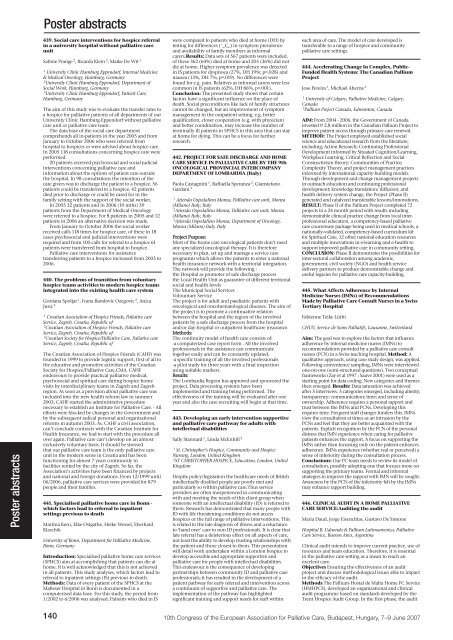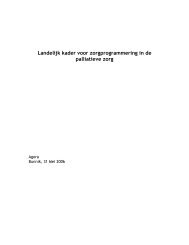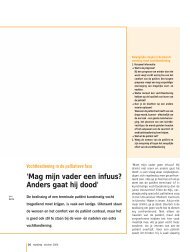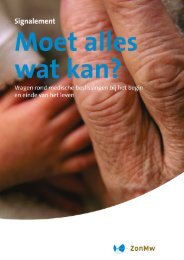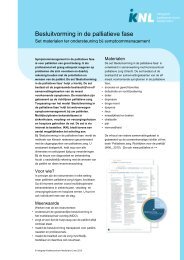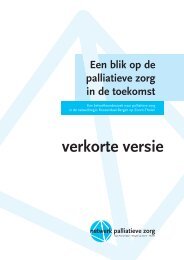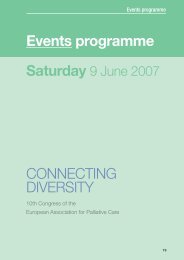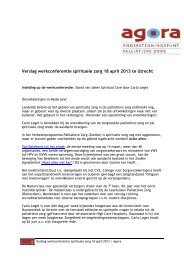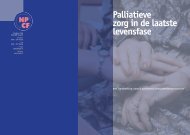Poster abstracts CONNECTING DIVERSITY
Poster abstracts CONNECTING DIVERSITY
Poster abstracts CONNECTING DIVERSITY
Create successful ePaper yourself
Turn your PDF publications into a flip-book with our unique Google optimized e-Paper software.
<strong>Poster</strong> <strong>abstracts</strong><br />
<strong>Poster</strong> <strong>abstracts</strong><br />
439. Social care interventions for hospice referral<br />
in a university hospital without palliative care<br />
unit<br />
Sabine Prange 2 , Ricarda Klein 3 , Maike De Wit 1<br />
1<br />
University Clinic Hamburg Eppendorf, Internal Medicine<br />
& Medical Oncology, Hamburg, Germany<br />
2<br />
University Clinic Hamburg Eppendorf, Department of<br />
Social Work, Hamburg, Germany<br />
3<br />
University Clinic Hamburg Eppendorf, Patient Care,<br />
Hamburg, Germany<br />
The aim of this study was to evaluate the transfer rates to<br />
a hospice for palliative patients of all departments of our<br />
University Clinic Hamburg-Eppendorf without palliative<br />
care unit or palliative care team.<br />
The data base of the social care department<br />
comprehends all in-patients in the year 2005 and from<br />
January to October 2006 who were referred from<br />
hospital to hospices or were advised about hospice care.<br />
In 2005 118 consultations concerning hospice care were<br />
performed.<br />
20 patients received psychosocial and social judicial<br />
interventions concerning palliative care and<br />
information about the options of patient care outside<br />
the hospital. In 98 consultations the intention of the<br />
care givers was to discharge the patient to a hospice. 56<br />
patients could be transferred to a hospice. 42 patients<br />
died prior to discharge or could be cared for in the<br />
family setting with the support of the social worker.<br />
In 2005 32 patients and in 2006 (10 mths) 39<br />
patients from the Department of Medical Oncology<br />
were referred to a hospice. For 8 patients in 2005 and 12<br />
patients in 2006 an alternative decision was made.<br />
From January to October 2006 the social worker<br />
received calls 118 times for hospice care, of these in 18<br />
cases psychosocial and judicial interventions were<br />
required and from 100 calls for referral to a hospice 61<br />
patients were transferred from hospital to hospice.<br />
Palliative care interventions for assistance<br />
transferring patients to a hospice increased from 2005 to<br />
2006.<br />
440. The problems of transition from voluntary<br />
hospice teams activities to modern hospice teams<br />
integrated into the existing health care system<br />
Gordana Spoljar 1 , Ivana Bandovic Ozegovic 2 , Anica<br />
Jusic 3<br />
1<br />
Croatian Association of Hospice Friends, Paliative care<br />
Service, Zagreb, Croatia, Republic of<br />
2<br />
Croatian Association of Hospice Friends, Paliative care<br />
Service, Zagreb, Croatia, Republic of<br />
3<br />
Croatian Society for Hospice/Palliative Care, Paliative care<br />
Service, Zagreb, Croatia, Republic of<br />
The Croatian Association of Hospice Friends (CAHF) was<br />
founded in 1999 to provide logistic support, first of all to<br />
the educative and promotive activities of the Croatian<br />
Society for Hospice/Palliative Care,CMA. CAHF<br />
endeavours to provide practical palliative medical,<br />
psychosocial and spiritual care during hospice home<br />
visits by interdisciplinary teams in Zagreb and Zagreb<br />
region. As soon as a provision about palliative care was<br />
included into the new health reform law in summer<br />
2003, CAHF started the administrative procedure<br />
necessary to establish an Institute for Palliative Care. - All<br />
efforts were blocked by changes in the Government and<br />
by the subsequent radical personal and organisational<br />
reforms in autumn 2003. As. CAHF a civil association,<br />
can’t conclude contracts with the Croatian Institute for<br />
Health Insurance, we had to start with the procedure all<br />
over again. Palliative care can’t develop on an almost<br />
exclusively voluntary basis. It should be stressed<br />
that our palliative care team is the only palliative care<br />
unit in the modern sense in Croatia and has been<br />
functioning for almost 7 years continuosly in<br />
facilities rented by the city of Zagreb. So far, the<br />
Association’s activities have been financed by projects<br />
and national and foreign donations. From 12/1999 until<br />
06/2006, palliative care services were provided for 879<br />
people and their families.<br />
441. Specialised palliative home care in Bonn -<br />
which factors lead to referral to inpatient<br />
settings previous to death<br />
Martina Kern, Elke Ostgathe, Heike Wessel, Eberhard<br />
Klaschik<br />
University of Bonn, Department for Palliative Medicine,<br />
Bonn, Germany<br />
Introduction: Specialised palliative home care services<br />
(SPHCS) aim at accomplishing that patients can die at<br />
home. It is well acknowledged that this is not achieved<br />
in all patients. This study analyses, which factors lead to<br />
referral to inpatient settings (IS) previous to death.<br />
Methods: Data of every patient of the SPHCS at the<br />
Malteser Hospital in Bonn is documented in a<br />
computerised data base. For this study, the period from<br />
1/2002 to 6/2006 was analysed. Patients who died in IS<br />
were compared to patients who died at home (DH) by<br />
testing for differences (¯_Ç_) in symptom prevalence<br />
and availability of family members as informal<br />
carers.Results: Data sets of 567 patients were included,<br />
of these 362 (64%) died at home and 205 (36%) did not<br />
die at home. Higher symptom prevalence was detected<br />
in IS patients for dyspnoea (27%, DH 19%; p=.028) and<br />
nausea (13%, DH 7%; p=.019). No differences were<br />
found for e.g. pain. Relatives as informal carers were less<br />
common in IS patients (62%, DH 86%, p


